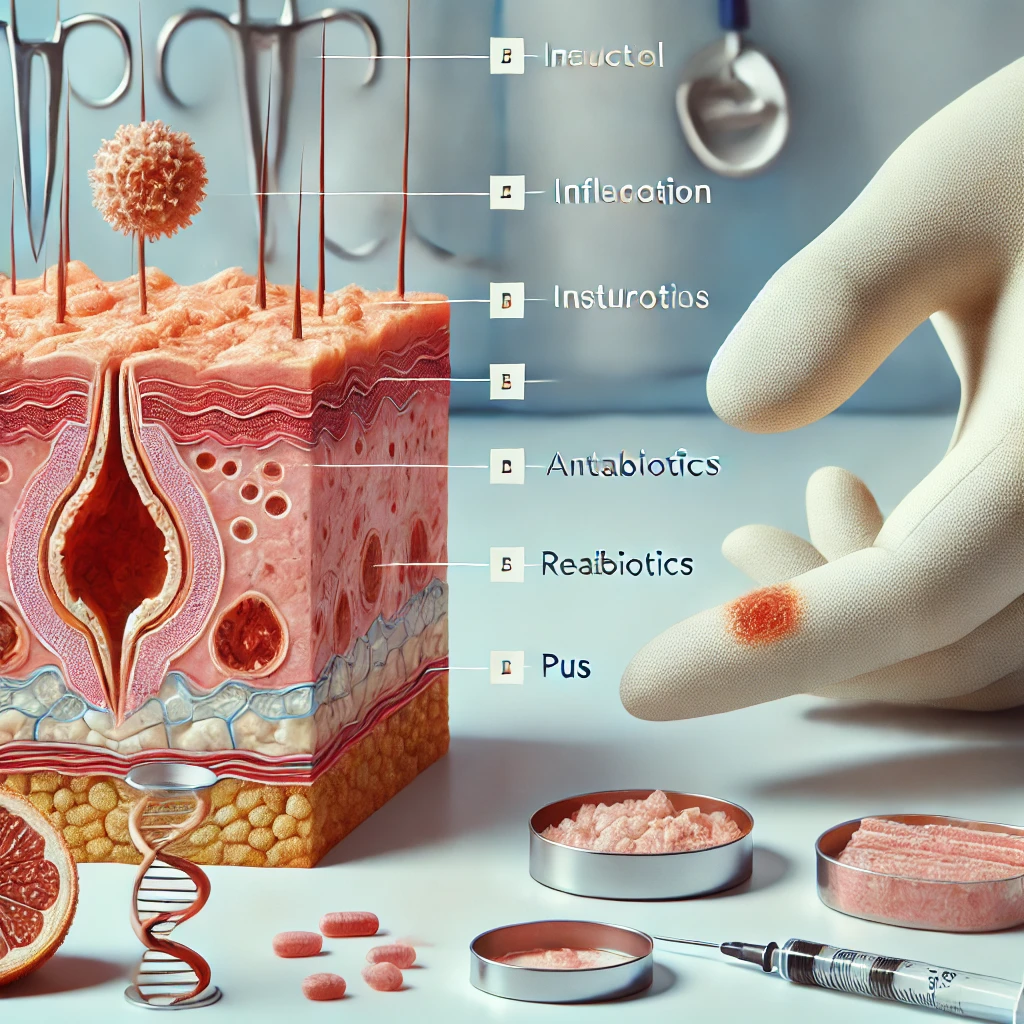An abscess is a painful collection of pus that forms due to an infection, typically caused by bacteria. While they can appear anywhere in the body, abscesses are most common in the skin and soft tissues. Recognizing the causes and understanding the treatment options are essential for proper healing and prevention of complications.
In this guide, we’ll explore:
- Common causes of an abscess.
- Treatment approaches.
- Healing stages with insights on “abscess healing stages pictures.
What is an Abscess?
An abscess is a localized infection that leads to a pus buildup of white blood cells, bacteria, and dead tissue. It creates a swollen, inflamed pocket that can be tender and painful.
Types of Abscesses:
- Skin Abscesses (Boils): Commonly appear on the skin’s surface, often due to blocked sweat glands or hair follicles.
- Internal Abscesses: Found in organs or tissues, such as the liver or abdomen, often resulting from internal infections.
- Dental Abscesses: Develop around the tooth or gums, usually due to untreated cavities or gum disease.
What Causes an Abscess?
The primary cause of abscesses is a bacterial infection, most commonly from Staphylococcus aureus. Other contributing factors include:
- Blocked Glands or Follicles:
- Sweat or oil glands can become blocked, trapping bacteria and leading to infection.
- Ingrown hairs may also contribute to abscess formation.
- Weakened Immune System:
- Conditions like diabetes or HIV can impair the immune system, making individuals more prone to infections.
- Trauma or Wounds:
- Cuts, punctures, or surgical incisions can introduce bacteria, resulting in an abscess.
- Chronic Inflammatory Conditions:
- Diseases like Crohn’s or hidradenitis suppurativa can lead to recurring abscesses.
- Poor Hygiene:
- Lack of proper skin care can increase the risk of infections that lead to abscesses.
Symptoms of an Abscess
Abscesses typically present with:
- Redness and swelling at the injection site.
- Pain that may worsen with pressure.
- Warmth and tenderness around the area.
- Fever and chills in severe cases.
- Pus drainage if the abscess ruptures.
Treating an Abscess
Effective treatment depends on the abscess’s size, location, and severity.
Home Remedies
- Warm Compresses: Applying heat to the area helps increase blood flow, which may encourage the abscess to drain naturally.
- Over-the-Counter Pain Relievers: Medications like ibuprofen can reduce pain and inflammation.
Medical Treatments
- Incision and Drainage:
- Performed by a healthcare professional, this procedure involves making a small cut to drain the pus.
- This is the most common treatment for skin abscesses that do not drain independently.
- Antibiotics:
- Oral or topical antibiotics may be prescribed to eliminate the underlying infection.
- It is commonly used for larger abscesses or when systemic symptoms are present.
- Surgical Intervention:
- Necessary for deep or internal abscesses. Imaging techniques like ultrasound or CT scans are often used to guide the procedure.
Prevention Tips
- Maintain good hygiene, especially after injuries or surgeries.
- Avoid squeezing or popping abscesses at home.
- Seek prompt medical attention for infections or wounds that worsen.
Abscess Healing Stages and What to Expect
The healing process of an abscess involves several stages. Images of these stages, often searched as “abscess healing stages pictures,” can help patients understand what’s expected during recovery.
Stage 1: Formation
- Appearance: The area is red, swollen, and painful. A bump may form as pus collects under the skin.
- What to Do: Seek medical attention for early signs of infection.
Stage 2: Drainage
- Appearance: If untreated, the abscess may rupture, releasing pus.
- Medical Attention: An incision and drainage procedure may be required for proper cleaning.
Stage 3: Granulation
- Appearance: After the pus is drained, the body forms new tissue to fill the cavity.
- Signs of Healing: Reduced swelling, less pain, and no pus.
Stage 4: Scabbing and Skin Restoration
- Appearance: A scab forms over the healing tissue, and the area may itch as new skin grows.
- Healing Time: Full recovery may take 1-2 weeks for smaller abscesses and longer for larger ones.
When to Seek Medical Help
While many abscesses heal with proper care, sure signs warrant immediate medical attention:
- Fever, chills, or rapid heart rate.
- Persistent pain or swelling despite treatment.
- Abscesses larger than a few centimetres.
- Recurring abscesses in the same area.
Common Myths About Abscess Treatment
Myth 1: You Can Always Treat Abscesses at Home
Fact: While minor abscesses may heal with home care, more significant or more severe infections require professional treatment.
Myth 2: Antibiotics Alone Can Cure All Abscesses
Fact: Antibiotics are often insufficient without proper drainage of the infected pus.
Myth 3: Popping an Abscess at Home is Safe
Fact: Squeezing an abscess can push the infection deeper, increasing the risk of complications like cellulitis.
Conclusion
Abscesses can be painful and potentially serious if left untreated, but understanding their causes, treatment options, and healing stages can empower patients to take timely action. By recognizing the symptoms and seeking appropriate care, you can ensure a quicker recovery and prevent recurrence.
For a visual guide, including pictures of abscess healing stages, consider consulting trusted healthcare resources to better understand the progression and recovery process.
